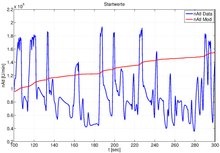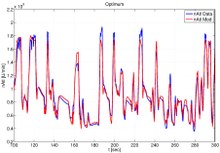WORHP
| WORHP
|
|
|---|---|
| Basic data
|
|
| developer | Christof Büskens , Matthias Gerdts et al. |
| Publishing year | 2010 |
| Current version | 1.14 (May 22, 2020) |
| operating system | Linux , Microsoft Windows |
| programming language | ANSI C , FORTRAN 77 , Fortran 95 and Fortran 2003 |
| category | Mathematics , optimization (mathematics) |
| License | Proprietary , Free of charge for academic purposes |
| German speaking | No |
| worhp.de | |
WORHP [ wɔːrp ], also known as “eNLP” ( NLP solver) at ESA , is a mathematical program or library for the numerical solution of continuous high-dimensional non - linear optimization problems . The abbreviation worhp means literally ' W e O ptimize R eally H uge P roblems "(" We optimize really big problems "), this is the primary area of application of the software. Worhp is hybrid in the languages Fortran and C implemented and also offers the Possibility to be integrated into C / C ++ and Fortran programs via various interfaces . In addition, there are interfaces for integration into the modeling environments Matlab , CasADi and AMPL .
Formulation of the problem
WORHP is designed to solve problems of form
- under
to solve with sufficiently smooth functions (objective function) and (constraints), which may be non-linear and need not necessarily be convex. Even problems with very large dimensions and can be solved efficiently if the problem is sparsely populated ; the highest dimensions achieved so far are in the order of magnitude . Problems in which it is not possible to evaluate the objective function and constraints separately, or in which it is possible to evaluate the constraints element by element, can be used by WORHP to make the calculation efficient.
Derivatives
WORHP requires the first derivative ( gradient ) of and from ( Jacobi matrix ) and the second derivative ( Hesse matrix ) of the Lagrange function ; in a modeling environment like AMPL these can be made available through automatic differentiation , but in other applications they have to be passed by the user. First and second derivatives can be determined by WORHP with the help of finite differences. In order to avoid the very high number of function evaluations that typically result in high-dimensional, sparse applications, graph coloring theory is used to group first and second derivatives. Second derivatives can also be approximated by variations of the classic BFGS method, including block-diagonal and thinly populated variants. WORHP implements a structure-preserving (possibly sparse) S BFGS method as the first NLP method, for which there is a proof of convergence.
structure
At the NLP level, WORHP is based on a classic SQP algorithm, whereas the quadratic sub - problems are solved with the help of interior point methods . This structure was chosen to benefit from the robustness of SQP methods and the reliable numerical effort of IP methods, since classic active set strategies are unsuitable for high-dimensional problems.
development
The development of WORHP started in 2006 with funding from the German Aerospace Center and was continued under the name "eNLP" after 2008 with the support of ESA / ESTEC together with the internal point solver ipfilter. The aim was to implement an NLP solver for determining optimal trajectories , for mission analysis and for space applications in general. (The use of Ipfilter in WORHP was not pursued after 2010.) The Steinbeis Research Center for Optimization, Control and Regulation and scientists from the Optimization and Optimal Control working group at the University of Bremen and the University of the Federal Armed Forces in Munich are working on the further development of WORHP. The developers of WORHP emphasize that despite its academic origins, it was developed from the start as an industrially usable tool, rather than as a pure research platform.
Applications
WORHP was integrated into programs for analyzing trajectories such as LOTNAV and ASTOS, and is used at ESOC and ESTEC. It is also possible to integrate WORHP as an optimizer in CasADi (from version 1.5.0 beta) and it is used as a local optimizer in the SVAGO MDO program, developed at the University of Bremen and at the Politecnico di Milano , for multidisciplinary optimization in the ESA PRESTIGE program .
Individual evidence
- ↑ WORHP interfaces . Archived from the original on December 7, 2013. Info: The archive link was automatically inserted and has not yet been checked. Please check the original and archive link according to the instructions and then remove this notice. Retrieved May 27, 2013.
- ↑ Patrik Kalmbach: Efficient derivative determination with high-dimensional nonlinear optimization . University of Bremen, Bremen June 23, 2011, urn : nbn: de: gbv: 46-00102087-10 (dissertation).
- ↑ Luis Vicente, Renata Silva, Michael Ulbrich, Stefan Ulbrich: ipfilter - An NLP Solver based on a primal-dual interior-point filter algorithm . Retrieved May 27, 2013.
- ^ Sven Erb: eNLP: application-centric NLP-based optimization in the aerospace market . March 2, 2011. Retrieved October 23, 2013.
- ↑ Development team . Retrieved January 9, 2018.
- ↑ Christof Büskens, Dennis Wassel: The ESA NLP Solver WORHP . In: Giorgio Fasano, János D. Pintér (eds.): Modeling and Optimization in Space Engineering (= Springer Optimization and Its Applications ). tape 73 . Springer, 2013, ISBN 978-1-4614-4469-5 , doi : 10.1007 / 978-1-4614-4469-5_4 .
- ↑ JL Cano, M. Bello, J. Rodriguez-Canabal: Navigation and Guidance for Low-Thrust Trajectories, LOTNAV . 2004, bibcode : 2004ESASP.548..609C
- ↑ CasADi wiki . Retrieved May 27, 2013.
- ↑ Francesco Castellini: PRESTIGE MDO research, Research Achievements . 2009. Archived from the original on October 1st, 2011. Info: The archive link was automatically inserted and has not yet been checked. Please check the original and archive link according to the instructions and then remove this notice. Retrieved March 23, 2011.
- ↑ ESA education: Universities selected for PRESTIGE programs . 2009. Retrieved March 23, 2011.












